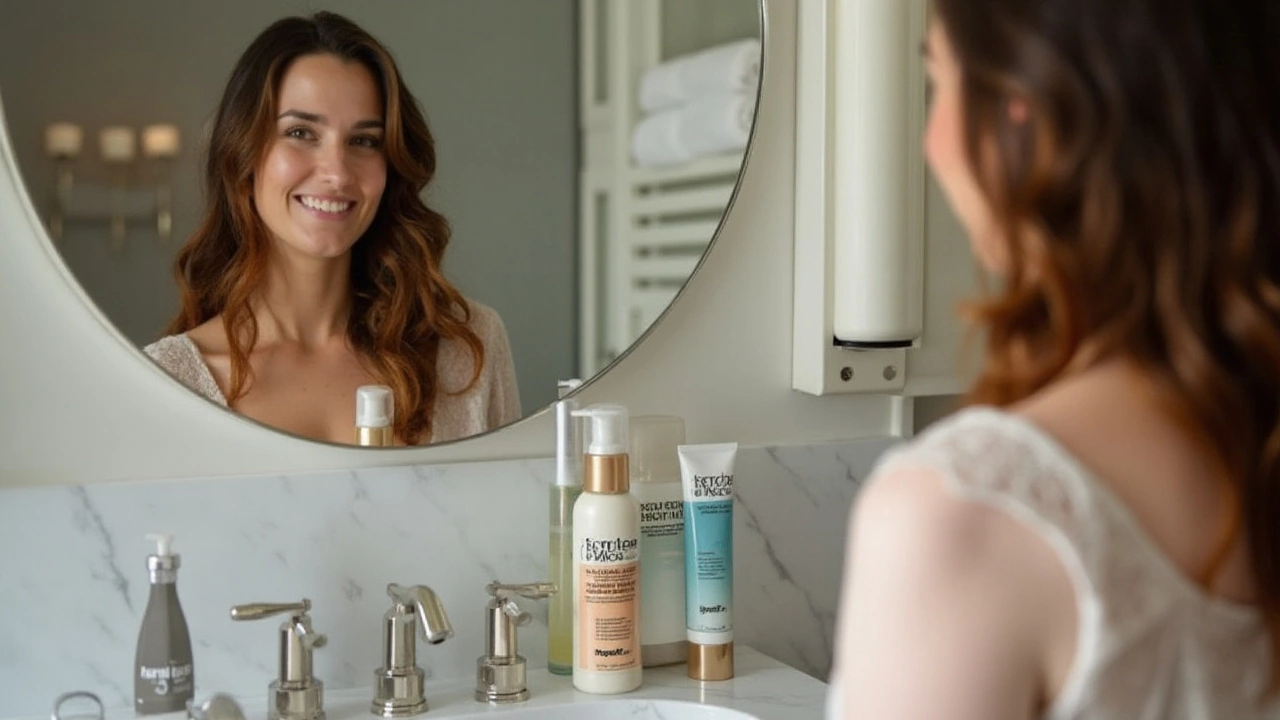Boosting the Density of Thin Hair with Effective Strategies
 Dec, 25 2024
Dec, 25 2024
For many individuals, thin hair can feel like a perpetual challenge, but fret not, as there's hope for those wanting to add some lushness to their locks. Increasing the density of your hair isn’t just about finding the right shampoo or styling product; it delves deeper into understanding the nature of your hair and taking a holistic approach.
With science, nutrition, and some good old-fashioned tips and tricks, boosting hair density can be an attainable goal. It's about marrying the right products with a solid routine from diet to a smart selection of hair care items, all designed to give your hair that much-desired fullness.
In this guide, we’ll journey through key insights and actionable steps that put the power back in your hands to enhance the thickness and fullness of your hair substantially. Let's explore this together and unveil the secrets to denser hair.
- Understanding Hair Density
- Diet and Nutrition for Hair Health
- Hair Care Products That Boost Volume
- Natural Remedies to Improve Thickness
- Effective Styling Tips for Fuller Hair
Understanding Hair Density
When we talk about hair density, it relates to the number of hair strands growing per square inch of your scalp. Hair density isn't just a concern about how your hair feels when you touch it; it intricately ties with how it looks. Different people sport varied hair densities, and this genetic aspect plays a significant role. Generally, those with a higher hair density have more fullness, while sparser densities might lead to a perception of thin hair. However, it's important to note that having thin hair doesn’t necessarily mean you have fewer hair follicles, but rather, each strand of hair is thinner, affecting overall volume.
This measurement of hair plays a crucial role in styling and hair care choices. It's a fundamental characteristic, often categorized as low, medium, or high density. Hair stylists often say, 'knowing your hair density is key to styling,' guiding users towards products tailored for their specific type. For instance, people with higher densities often opt for thinning shampoos, while those with low density may gravitate towards volumizing products.
"Hair density impacts not only the health of hair but also its nourishment needs," says Dr. Jane Simmons, a leading trichologist.
Several factors contribute to the apparent density of **thin hair**, beyond genetics alone. Age, diet, hormonal changes, and even stress have marked effects. Over time, hair follicles can shrink, resulting in finer hair, which often gives an impression of reduced density. Sometimes, increasing the visible density is about catering to these factors, implementing improved lifestyle choices, and adopting the right hair care routines. The impact of a nutrient-rich diet and adequate hydration cannot be overstated, providing essential fuel to hair follicles. A fascinating aspect of hair density is its adaptability; utilizing specialized hair care products can temporarily enhance hair thickness by providing moisture and support to each strand, offering a fuller appearance. Hence, understanding how genetics, lifestyle, and product choice intertwine aids significantly in effective hair management.
Recent studies suggest that around 40% of women experience some form of thinning by the time they reach 50, highlighting the importance of proactive understanding and action. Ethnicity also plays a role where, for example, people of Asian descent generally have lower hair density but thicker strands compared to Caucasian or African descent individuals. In this dynamic, the choice of hair care products makes a tangible difference—specifically those labeled for density or volume enhancer that plump up thinner strands, improving both physical and perceived (**hair density**).
Diet and Nutrition for Hair Health
Our quest for thicker thin hair often leads us to look outward, focusing on the products we can apply from roots to tips. However, there’s an inner world of nutrition and diet that can play a massive role in your hair's appearance. What we consume directly influences our bodily functions, hair density included. Vitamins, minerals, and proteins are the bedrock of healthy hair, ensuring each strand grows strong and robust. Consuming a diet rich in essential nutrients not only aids in thwarting hair thinning but promotes a bounce and shine many desire.
Protein stands as the core building block for hair; after all, hair itself is primarily composed of a protein called keratin. Ensure you get a sufficient amount by incorporating lean meats, fish, eggs, and plant-based proteins like beans and lentils. Omega-3 fatty acids, often hailed for their health benefits, also play an essential part in keeping hair follicles hydrated and nourished, preventing them from drying out and breaking. Found in fatty fish like salmon and mackerel, as well as flaxseeds and walnuts, omega-3s should not be overlooked. Iron levels are equally significant, and a deficiency can lead to some disastrous hair fall. Ensure your diet includes sources like spinach, red meat, and legumes to keep your iron levels topped up.
But vitamins cannot be sidelined when we talk about diet’s influence on hair. Vitamins A and C, for instance, work together in keeping the scalp hydrated by supporting the sebum production. Additionally, Vitamin C helps the body in the absorption of iron, creating a strong combination essential for promoting good hair care. Foods such as carrots, sweet potatoes, strawberries, and citrus fruits are wonderful vitamin sources. In a meaningful statement about the power of diet, the British Journal of Dermatology noted, "Nutritional deficiencies have been reported to impact hair growth, texture, and overall appearance, influencing hair density significantly."
Biotin, a B-vitamin known for its role in creating the protein structures of hair thickness, is a critical component to complement your diet. Foods like nuts, seeds, and whole grains are great inclusions. Zinc is another player in maintaining the oil-secreting glands around follicles working in top condition. Opt for enriching your meals with pumpkin seeds, lentils, and chickpeas. Always remember, a balance of nutrients is key; a colorful and diversified plate translates to a head of fuller hair. Embrace the variety in your diet, and let the nutrition from within shine through your hair.

Hair Care Products That Boost Volume
For those grappling with thin hair woes, exploring products designed to create volume is an essential step. The journey to achieving visibly thicker hair often starts with the right shampoo and conditioner. Thin hair can benefit from volumizing shampoos that gently cleanse without weighing your strands down. Ingredients like biotin, keratin, and collagen can help fortify each strand, promoting a thicker appearance over time.
When it comes to conditioners, light formulations that provide moisture without adding extra weight are key. Think of products infused with natural oils or aloe vera, which hydrate the hair but won't leave it limp. Many agree that using a leave-in conditioner can further amplify the voluminous effect by offering additional protection and nourishment, ensuring every strand looks its fullest.
Alongside traditional hair care essentials, volumizing mousses, sprays, and texturizers also play a vital role. They are crafted to lift roots and add body, particularly for those with fine hair. It's worth noting that many expert stylists recommend styling products that contain proteins.
“Proteins can temporarily fill in gaps along the hair shaft, increasing density,” explains renowned stylist Jane Smith.Considering this, when applying these products, targeting areas that need the most lift, such as the roots, can create an immediate perceptible difference.
For an even more substantial lift, powders that absorb oil and offer a dry, texture-rich finish work wonders. These hair care heroes are especially handy for those midday touch-ups when your hair might start to feel flat after a morning style. They provide longevity to your look, allowing your hair to appear fresh and voluminous throughout the day.
Incorporating volumizing products into a routine isn't just about the ingredients; it's also about the application technique. Massaging shampoos into the scalp promotes circulation, bolstering hair growth and volume. And don't disregard the role of drying techniques; opting for a blowout with a round brush can achieve heights you might not get merely from air-drying.
Choosing the Right Products
When selecting a product arsenal for enhancing volume, reading labels and researching is vital. Opt for brands acclaimed for their efficacy in promoting thickness and vitality. Yet, beyond mere brand names, check for specific mentions of cruelty-free practices, as this ensures sustainability while caring for your hair. Many remain unaware that sustainable brands are often pioneers in incorporating scientifically-backed ingredients that make a difference.
| Product Type | Key Ingredient | Purpose |
|---|---|---|
| Shampoo | Biotin | Strengthens hair shafts |
| Conditioner | Aloe Vera | Hydrates without weight |
| Mousse | Keratin | Boosts hair body |
Arming yourself with the right knowledge and products tailored to your unique needs is paramount for transforming thin hair into a luscious mane full of life. With careful attention and the right routine, adding volume to your hair is no longer a challenging aspiration but an attainable reality.
Natural Remedies to Improve Thickness
Imagine stepping out with a mane so full and vibrant, it turns heads wherever you go. When dealing with thin hair, the dream of thicker strands might seem distant, yet nature has a plethora of remedies to offer. Many people are unaware that their pantry holds little-known secrets that can transform the thin wisps into lustrous tresses bursting with life. The journey begins with understanding how to harness the power of ingredients you probably already have at home.
One popular natural remedy is the use of coconut oil. Rich in fatty acids, coconut oil penetrates deep into the hair shaft, providing moisture and nutrition that can thicken hair over time. By massaging a few tablespoons of this exotic oil into your scalp and letting it sit for an hour before washing, you can enhance hair's resilience and luster. Science supports these benefits, and it's backed by ages of anecdotal evidence. This treatment, practiced once a week, could significantly improve the appearance of hair density.
Another well-regarded method involves the magical properties of aloe vera. This succulent plant has been heralded for centuries for its healing abilities. The enzymes in aloe vera remove dead scalp cells that might be clogging hair follicles and preventing essential nutrients from nourishing the hair. Applying fresh aloe gel directly onto the scalp and letting it sit for about 30 minutes can revitalize your hair with its natural properties. According to a study by the National Center for Biotechnology Information, aloe vera improves circulation, which can fuel hair care and support new growth.
The potent effects of rosemary oil deserve a special mention. Rosemary isn’t just a fragrant herb used to enhance your culinary delights; its oil is a powerhouse for hair growth. A few drops blended with a carrier oil can be applied to the scalp with a gentle massage, boosting circulation to the hair follicles. In a comparative study published in the journal Skinmed, rosemary oil's effects on hair thickening and growth were comparable to minoxidil, a common hair regrowth treatment. If you’re looking for a chemical-free approach, rosemary oil could be your ally.
And let's not forget the power of good nutrition in nature-based remedies. Eating a diet rich in vitamins and minerals, such as biotin (found in nuts and eggs) and omega-3 fatty acids (prevalent in fish like salmon), supplies the body with essential ingredients for building hair strength from the inside out. Harvard Health Publishing frequently highlights the importance of balanced nutrition in maintaining healthy skin and hair. Implementing some dietary changes can offer significant support in your quest for denser hair.
Embrace the tools that nature has generously provided and witness the transformation. With dedication and the right ingredients, your journey towards achieving improved hair thickness can be a rewarding and enriching process, both for your scalp and your soul.

Effective Styling Tips for Fuller Hair
Many seek an immediate solution to make thin hair appear fuller, and styling techniques play a crucial role in this quest. The trick is to add volume in such a way that it gives the illusion of denser hair. One often underestimated tool is the humble hairdryer. When used correctly, with a focus on lifting roots while drying, a hairdryer can create a significant volume boost. Don’t forget the magic of a round brush—it’s your ally in creating a bouncy finish. Begin by flipping your hair upside down during the blow-drying process. This position helps by giving gravity a chance to lift your roots further off your scalp, creating a natural, fuller look when you stand upright.
Equally, curling techniques can work wonders for creating the appearance of thicker hair. Soft waves can make individual strands visually overlap, providing breath-taking volume. Opt for a medium-sized curling iron and wrap small sections of your hair around the barrel for a few moments. Remember to go gentle on the heat to avoid damaging fine hair. Hair protection spray is a must-have for protecting these fragile strands. Creating loose waves is not only trendy but also gives your hair more body.
Choosing the right haircut is fundamental. Layers can add texture and volume, especially around the face and crown. A trusted stylist should know how to layer your hair to maximize body without compromising the health of the strands. A bob with layers or a shag cut can provide lively volume and help you achieve that thicker look you crave. Layers aren’t just stylistic; they can also remove the weight from heavier hair, giving it a natural lift.
If you wish to add both volume and length temporarily, consider hair extensions. Clip-in extensions or halo options can provide a quick fix without the commitment of permanent extensions. These can be easily styled to match your natural hair or add volume where you need it most. It’s important, however, to ensure that these extensions match your hair color and texture seamlessly to maintain a natural appearance. By focusing on the right mix of styling products, tools, and techniques, you can confidently step out with hair that looks fabulously full and thick.
"The best way to learn how to style thin hair is through trial and error," says celebrity hairstylist Chris Appleton. "Don't be afraid of experimenting with different products and tools to see what gives you the best volume."
And speaking of products, while styling, take advantage of volumizing mousses or thickening creams. These products can prep hair before drying or styling, offering an instant lift that stays throughout the day. However, be cautious not to weigh down fine hair with too much product. Less is more; apply a small amount to the roots and blow-dry for added volume. Dry shampoos can also be a game changer by adding texture and absorbing excess oils that might make hair limp. Applied strategically, these products are essential tools in your hair styling arsenal, working best on dry hair.
